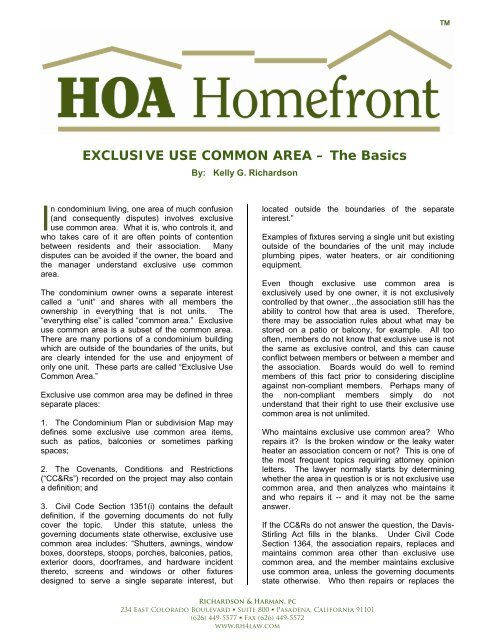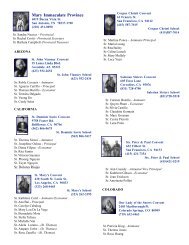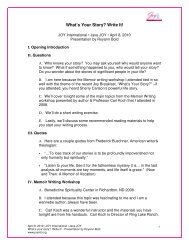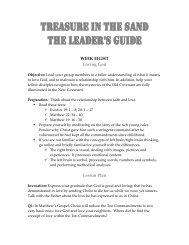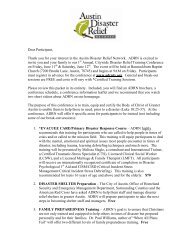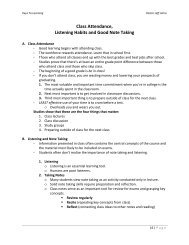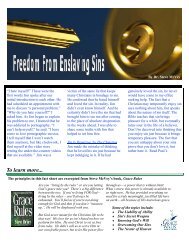⢠EXCLUSIVE USE COMMON AREA â The Basics
⢠EXCLUSIVE USE COMMON AREA â The Basics
⢠EXCLUSIVE USE COMMON AREA â The Basics
Create successful ePaper yourself
Turn your PDF publications into a flip-book with our unique Google optimized e-Paper software.
<strong>EXCLUSIVE</strong> <strong>USE</strong> <strong>COMMON</strong> <strong>AREA</strong> – <strong>The</strong> <strong>Basics</strong><br />
By: Kelly G. Richardson<br />
I<br />
n condominium living, one area of much confusion<br />
(and consequently disputes) involves exclusive<br />
use common area. What it is, who controls it, and<br />
who takes care of it are often points of contention<br />
between residents and their association. Many<br />
disputes can be avoided if the owner, the board and<br />
the manager understand exclusive use common<br />
area.<br />
<strong>The</strong> condominium owner owns a separate interest<br />
called a “unit” and shares with all members the<br />
ownership in everything that is not units. <strong>The</strong><br />
“everything else” is called “common area.” Exclusive<br />
use common area is a subset of the common area.<br />
<strong>The</strong>re are many portions of a condominium building<br />
which are outside of the boundaries of the units, but<br />
are clearly intended for the use and enjoyment of<br />
only one unit. <strong>The</strong>se parts are called “Exclusive Use<br />
Common Area.”<br />
Exclusive use common area may be defined in three<br />
separate places:<br />
1. <strong>The</strong> Condominium Plan or subdivision Map may<br />
defines some exclusive use common area items,<br />
such as patios, balconies or sometimes parking<br />
spaces;<br />
2. <strong>The</strong> Covenants, Conditions and Restrictions<br />
(“CC&Rs”) recorded on the project may also contain<br />
a definition; and<br />
3. Civil Code Section 1351(i) contains the default<br />
definition, if the governing documents do not fully<br />
cover the topic. Under this statute, unless the<br />
governing documents state otherwise, exclusive use<br />
common area includes: “Shutters, awnings, window<br />
boxes, doorsteps, stoops, porches, balconies, patios,<br />
exterior doors, doorframes, and hardware incident<br />
thereto, screens and windows or other fixtures<br />
designed to serve a single separate interest, but<br />
located outside the boundaries of the separate<br />
interest.”<br />
Examples of fixtures serving a single unit but existing<br />
outside of the boundaries of the unit may include<br />
plumbing pipes, water heaters, or air conditioning<br />
equipment.<br />
Even though exclusive use common area is<br />
exclusively used by one owner, it is not exclusively<br />
controlled by that owner…the association still has the<br />
ability to control how that area is used. <strong>The</strong>refore,<br />
there may be association rules about what may be<br />
stored on a patio or balcony, for example. All too<br />
often, members do not know that exclusive use is not<br />
the same as exclusive control, and this can cause<br />
conflict between members or between a member and<br />
the association. Boards would do well to remind<br />
members of this fact prior to considering discipline<br />
against non-compliant members. Perhaps many of<br />
the non-compliant members simply do not<br />
understand that their right to use their exclusive use<br />
common area is not unlimited.<br />
Who maintains exclusive use common area Who<br />
repairs it Is the broken window or the leaky water<br />
heater an association concern or not This is one of<br />
the most frequent topics requiring attorney opinion<br />
letters. <strong>The</strong> lawyer normally starts by determining<br />
whether the area in question is or is not exclusive use<br />
common area, and then analyzes who maintains it<br />
and who repairs it -- and it may not be the same<br />
answer.<br />
If the CC&Rs do not answer the question, the Davis-<br />
Stirling Act fills in the blanks. Under Civil Code<br />
Section 1364, the association repairs, replaces and<br />
maintains common area other than exclusive use<br />
common area, and the member maintains exclusive<br />
use common area, unless the governing documents<br />
state otherwise. Who then repairs or replaces the<br />
Richardson & Harman, pc<br />
234 East Colorado Boulevard • Suite 800 • Pasadena, California 91101<br />
(626) 449-5577 • Fax (626) 449-5572<br />
www.rh4law.com
exclusive use common area <strong>The</strong> section only says<br />
that the member must maintain it. Most legal<br />
practitioners resolve this hole in the statute in favor of<br />
the member, and opine that the association is<br />
required to repair and replace exclusive use common<br />
area items, unless the governing documents state<br />
otherwise. To fill this hole, many associations amend<br />
their governing documents to clarify this issue.<br />
So, “use” is not the same as “control,” and<br />
maintenance responsibility may be different than<br />
repair responsibility. Recognition of this will help<br />
reduce association conflict.<br />
Quick Tip: Read California law yourself at<br />
www.leginfo.ca.gov/calaw.html. For the Davis-<br />
Stirling Act click on “Civil Code” then on<br />
“Search.” Scroll down to the sections starting at<br />
1351, where it starts.<br />
Kelly G. Richardson, Esq. is Managing Partner of Richardson & Harman PC, a<br />
California law firm known for real estate and community association advice. Mr.<br />
Richardson is author of the “HOA Homefront” column, appearing in twelve<br />
newspapers throughout Southern California, and is a member of the College of<br />
Community Association Lawyers of the Community Associations Institute. For<br />
past columns, visit www.HOAHomefront.com, or check the HOA Homefront page<br />
on Facebook or Twitter. Direct e-mail questions to KRichardson@RH4Law.com<br />
All rights reserved®.<br />
Richardson & Harman, pc<br />
234 East Colorado Boulevard • Suite 800 • Pasadena, California 91101<br />
(626) 449-5577 • Fax (626) 449-5572<br />
www.rh4law.com<br />
-2-


